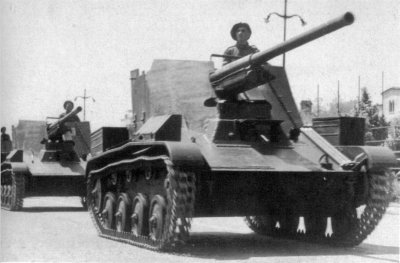It's kind of funny that people are talking about making revolvers as a 'stopgap' (which are not actually simpler than automatics) and then cooking up some kind of gas-seal rifle-caliber monstrosity. Probably better off with an obrez at that point.
Or just issuing all officers carbines, and if this makes them feel unfashionable next to our snappily-dressed Japanese advisors, they can buy their own pistol from wherever out of their own money.
It is, because a scaled up rifle, even if it weighs in the area of 20 pounds, is still way, waaayyy more portable than a heavy machine gun with its carriage, ammunition, and the amount of crew needed to operate it. That being said:
We don't have to go for something in 75mm. Most countries during this time period in fact fielded something around 37mm, which while light by the time of hostilities, is definitely applicable to our situation. Though for this one I would say splurge and go for something around 40-57mm, as they stay relevant longer and have much better performance. We're kind of in the situation where, while we're poor as a country, we can't really be cheap either.
Edit:
On the topic of pistols; We're in the unique situation where we could design a revolver based around our rifle cartridge. It would not be pleasant to shoot for any person, but 6.5x50mm is a Semi-rimmed cartridge (which is a big help compared to rimless for extraction), and relatively tiny compared to other rifle calibers of the period. If push comes to shove, an overbuilt, 5-7 shot revolver with the option for a stocked carbine version is definitely something we could design.
So, this gets to force structure, with some confusion where some people are thinking one thing and others are thinking others.
Several people are assuming that anti-tank guns are a separate formation with their own specialised guns. This would be more flexible than dual-role field guns, but also require buying and supplying a bunch of AT guns.
Using a high-velocity field gun for both regimental artillery and heavy anti-tank work would be cheaper and logistically simpler, but tactically a bit awkward.
If buying dedicated AT guns, of course a 75mm would be massive overkill against current tanks. The 37mms wouldn't be effective against heavy tanks or medium tanks made after about 1941, but equally, Africa is exactly the kind of neglected secondary front where otherwise obsolete tanks go to die, so I dunno.
My proposal/expectation for the eventual army is something like this:
Regiment | Battalion | Company | Platoon | Squad |
| HMGs for AA & light AT | Gun-Mortar (70mm) | MMGs | Grenade Launchers | LMG |
| Field Guns (HV 75mm) | | AT Rifles | | Hand Grenades (!) |
This adds a battery of high-velocity field guns at the regimental level, for long-range artillery and heavy anti-tank.
The 70mm battalion guns seem to be a lot heavier than a medium mortar would be, without much more range, so I'm not sure about them.
But they're already in service and can be used for direct fire.
More of those and more MMGs would be good. Maybe also a battalion-level MMG platoon once there's enough? Would need the Type 3 factory crews to sober up first.
At the company level, adding an AT rifle section gives protection against armoured cars and light tanks without having to wait for the colonel to send some HMGs over. And in the absence of armour, I'm sure the troops can find all sorts of uses for a rifle that can blow straight through a brick wall.
The grenade launchers could as easily be light mortars at the company level, assuming there's a good one. Or rifle grenades instead, maybe. I'm not sure if any of those were much good.
The absence of actual hand grenades is a huge gap in the equipment. Apparently the Japanese ones were shit, aside from going in grenade dischargers. But there's always the Mills Bomb...
The descriptions of the terrain does sound like submachineguns would be a lot more useful than expected - a couple per squad could give assault elements a lot of bite. Sounds like a nightmare for armour, though.








